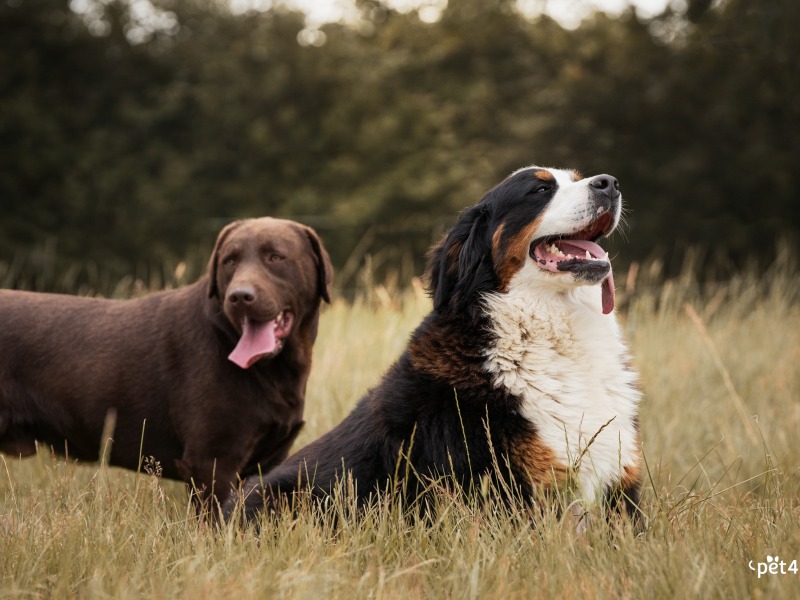Labrador-retriever
Welcome to our page dedicated to the breed of dog labrador-retriever!
Here, you will find all the useful information about labrador-retriever. This descriptive profile will allow you to discover the aspects of this breed. You can notably consult information about the average price, monthly and annual upkeep expenses, their health, name ideas, as well as their official recognition by competent authorities.
Explore this page to discover everything you need to know.
Overall description of the breed
The Labrador is a canine breed that traces its roots back to the United Kingdom, with a long history and close ties to ancestors such as the Newfoundland. Some argue that the St. John's dog, well-known in Canada, is also part of its lineage, sharing many physical similarities with the Newfoundland but in a more compact version.
In the early 19th century, the ancestors of the Labrador were imported to England by British settlers, where they played a crucial role as fishing dogs. Their courage and intelligence proved invaluable in tracking fish. They also excelled as hunters of small game, especially in aquatic environments. Over the decades, rigorous selection has strengthened this quality, making them prized partners for duck hunting.
The first breed club dedicated to the Labrador was founded in 1916, followed by a second one specifically for yellow Labradors in 1925. The name "Labrador" pays homage to the peninsula of the same name, a vast Canadian region located near the island of Newfoundland, where the ancestors of this breed originated.
The term "Retriever" means "to retrieve," highlighting the Labrador's instinctive ability to retrieve all kinds of prey. The Labrador was officially recognized by the International Canine Federation on December 24, 1954, and its current standard was published on October 13, 2010.
The Labrador is an extremely popular breed worldwide due to its cheerful appearance and robust health. It is of medium size, with a sturdy build and a rounded body, combining elegance and strength. Its body is slightly longer than tall, forming a rectangle.
The line of its back is short, distinct, and fleshy. It has a generous chest, a deep chest, and broad shoulders, as well as barrel-shaped, rounded ribs. Its hindquarters are muscular and powerful, giving it a strong start. Its tail, thick at the base, is of medium length and covered in fur.
The Labrador's head is wide, with a moderately long muzzle, although its jaws are relatively weak. Its coat is short, dense, and flat all over its body, and its compact texture makes it waterproof. Accepted coat colors for the Labrador Retriever are yellow (sable), black, and brown (chocolate).
This dog is known for its tenderness and love for its owners, which is not a legend. The Labrador is a very pleasant companion, gentle, and exceptionally sociable. It greatly enjoys family playtime and seems inexhaustible when it comes to participating in activities with loved ones. It seeks to adapt to the moods of the people around it. If it lives with a hyperactive person, it will be too.
If it lives in a peaceful environment, it will adapt to that tranquility. However, it has a vital need to expend its energy, and a daily walk is necessary for its mental well-being. Lack of activity can lead it to become destructive. The Labrador Retriever has a strong affinity for its owners and generally does not tolerate solitude well. If not accustomed to short absences from a young age, it can become anxious and cause material damage.
The Labrador Retriever is a dog that enjoys pleasing its loved ones. It is easy to train, attentive to its trainer, and aware of its surroundings. It excels in its role as a guide dog for the blind and is also used as a hunting dog, particularly for duck and waterfowl hunting. It is also an excellent partner for sports activities such as biking, jogging, hiking, etc.
However, it is important to monitor its diet as it has a tendency to be greedy and can easily gain weight. A balanced and well-measured diet is essential to maintain its health.
Finally, the Labrador Retriever is the ultimate family dog, affectionate and extremely loyal. It enjoys the constant presence of its family and devotes unconditional love to all members of its household. As an adult, it will reach a weight of approximately 30 kg (65 lbs), with a maximum shoulder height of 57 cm (22 inches) for males and 55 cm (21.5 inches) for females.
Awareness of acquiring an animal
Each animal is a sensitive being, deserving love, attention and care.
When you choose to adopt an animal, you take on the responsibility of ensuring its health and well-being throughout its life.
To learn more about animal welfare, we invite you to consult our FAQ by clicking the button below:
Origins
The Labrador Retriever has its origins in the Newfoundland region of Canada. This dog descends from the St. John's dog, a local breed used by fishermen to retrieve fish that had escaped from nets. Starting in the 19th century, English nobles imported these dogs to the United Kingdom, where they were crossed with other breeds such as the Setter and the Newfoundland. The goal was to improve their hunting and retrieving abilities. This strict selection process gave rise to the modern Labrador Retriever, known for its intelligence, robustness, and adaptability. Today, this breed is one of the most popular in the world, appreciated both as a family dog and for professional roles such as guide dogs, therapy dogs, or working dogs in law enforcement.
History
The history of the Labrador Retriever is marked by its evolution from the shores of Newfoundland to the domains of British nobility. Initially, the St. John's dog, ancestor of the Labrador, was used by Canadian fishermen to assist in their daily tasks. From the early 19th century, British aristocrats were enamored with the abilities of this dog and imported it to England. There, crossbreeding with other breeds was done to refine its qualities. In 1903, the breed was officially recognized by the British Kennel Club. Since then, the Labrador Retriever has gained popularity worldwide, not only for its hunting and retrieving skills, but also for its role in search and rescue, detection of illicit substances, and as a pet.
Standard
The Labrador Retriever breed standard is defined by specific criteria aimed at maintaining the unique characteristics of this dog. According to the FCI (Fédération Cynologique Internationale) standard, the Labrador is a medium-sized, well-proportioned and robust dog. Its head is wide with a pronounced stop, a powerful muzzle, and strong jaws. Its eyes should be hazel or brown in color, expressing gentleness and intelligence. The ears are of medium size, hanging close to the head. The body is compact with a straight backline, a wide and deep chest. The tail, often called an "otter tail", is thick at the base and tapers gradually. The limbs are strong and muscular, allowing for easy and powerful movements. The coat is short, dense, and water-resistant, with a soft undercoat.
Physical characteristics
The Labrador Retriever is a medium to large-sized dog, measuring between 56 and 57 cm for males and 54 to 56 cm for females, at the withers. Their weight usually ranges between 27 to 36 kg for males and 25 to 32 kg for females. Their coat is short, dense, and water-resistant, with a soft and thick undercoat that protects them from harsh weather conditions. The recognized colors are black, yellow (ranging from pale cream to fox red), and chocolate. The Labrador has a well-proportioned and muscular silhouette, with a wide head, expressive hazel or brown eyes, and drooping ears. Their characteristic tail, thick at the base and tapering towards the end, is often called an "otter tail". These physical characteristics contribute to their ability to work and their endurance.
Character
The Labrador Retriever is known for its gentle, friendly, and balanced character. It is a very sociable dog, which gets along well with children, other animals, and strangers. Its affectionate nature and desire to please make it an ideal companion for families. The Labrador is also very intelligent and easy to train, making it versatile in various roles such as a guide dog, therapy dog, or working dog. It is known for its patience and tolerance, traits that make it particularly well suited for family life. However, this breed requires a lot of attention and mental stimulation. The Labrador can be quite energetic and playful, needing regular exercise sessions to stay happy and healthy.
Life expectancy
The average life expectancy of a Labrador Retriever is between 10 and 14 years. This longevity can vary depending on several factors, such as genetics, diet, veterinary care, and lifestyle. To maximize your Labrador's lifespan, it is essential to provide balanced nutrition, regular exercise, frequent veterinary visits, and plenty of attention. Like all breeds, some Labradors may be predisposed to specific health problems that can affect their life expectancy, such as hip dysplasia, eye diseases, or heart disorders. Proactive care and good hygiene greatly contribute to the health and longevity of these dogs.
Exercise and activity needs
The Labrador Retriever is an extremely energetic breed that requires a lot of exercise and mental stimulation to be happy and healthy. An adult Labrador needs at least one to two hours of physical activity per day. This can include walks, fetch games, swimming sessions, or even agility courses. In addition to physical exercise, Labradors greatly benefit from mental stimulation, such as interactive games, chew toys, and regular obedience training. Boredom can lead to destructive behaviors, so it is crucial to maintain a routine of activity. Labradors are also known for their love of water, so aquatic activities are particularly appreciated.
Recommended diet
To ensure optimal health for your Labrador Retriever, it is crucial to provide them with a balanced and high-quality diet. A diet tailored to this breed should include high-quality proteins, healthy fats, fibers, as well as the necessary vitamins and minerals. Premium kibble or wet food specially formulated for large active breeds is recommended. On average, the monthly cost of feeding a Labrador ranges between 50 and 100 euros. This amount may vary depending on the brand of food chosen and your dog's specific needs. It is also important to monitor their weight and adjust their food portions accordingly to prevent obesity, a common issue among Labradors.
Training and obedience
The Labrador Retriever is known for its intelligence and desire to please, making it an ideal student for education and training. Positive reinforcement methods, such as food rewards, petting, and verbal praise, are particularly effective with this breed. It is crucial to start training at a young age to establish good habits. Labradors quickly learn basic commands such as "sit", "lie down", "come" and "stay". Training sessions should be short and varied to maintain the dog's interest. Due to their sociable nature, Labradors also benefit from socializing with other dogs and humans from a young age, which contributes to their balanced development and friendly behavior.
Behavior with children
The Labrador Retriever is often described as the ideal companion for families with children. Its gentle, patient and tolerant nature makes it an excellent companion for younger ones. It is known for its ability to adapt to various family environments and interact positively with children. The Labrador is generally very protective of its family members, including children, and enjoys participating in family activities. However, as with any dog, it is important to supervise interactions between the dog and young children to ensure everyone's safety. Children should also be educated on how to respectfully treat the dog. Overall, with proper socialization and training, the Labrador quickly becomes a loving and loyal member of the family.
Compatibility with Other Animals
The Labrador Retriever is known for its friendly and sociable temperament, which generally makes it compatible with other pets. Whether with other dogs, cats, or even small animals, the Labrador adapts well thanks to its gentle and patient nature. It is important to gradually introduce the Labrador to other animals and monitor initial interactions to ensure a harmonious cohabitation. Socialization from a young age plays a crucial role in this compatibility. Labradors who have been properly socialized tend to be less territorial and more tolerant. However, every dog is an individual, and precautions should be taken to ensure that all pets get along well.
Grooming needs
The Labrador Retriever has a dense, water-resistant double coat that requires regular maintenance to keep it in good condition. Weekly brushing is recommended to remove dead hair and reduce the amount of shedding in the house. During shedding seasons, typically in the spring and fall, daily brushing may be necessary. Baths should be given occasionally, about once every two to three months, unless the dog is particularly dirty or smelly. The Labrador's ears should be checked regularly to prevent infections, and nails should be trimmed monthly. Special attention should also be paid to the teeth, which should be brushed several times a week to prevent dental diseases.
Health
The Labrador Retriever is generally a robust breed, but is prone to some health problems. Among the most common conditions are hip and elbow dysplasia, genetic joint disorders. Labradors may also be predisposed to eye diseases, such as cataracts and retinal dysplasia. Obesity is another common issue with this breed, which can lead to additional complications such as diabetes and heart disease. Labradors may also suffer from skin allergies and ear infections due to their floppy ears. Regular veterinary monitoring, balanced nutrition, and adequate exercise are essential to keep a Labrador healthy and detect potential problems early on.
Average price
The average price of a Labrador Retriever puppy varies depending on several factors, such as the breeder's reputation, the dog's lineage, and the region. In France, the cost of a Labrador Retriever generally ranges from 800 to 1500 euros. Puppies from champion bloodlines or with parents who have won prizes in dog competitions can cost more, sometimes up to 2000 euros or more. It is crucial to choose a reputable breeder who adheres to animal health and welfare standards, even if it means paying a little more. Labradors from shelters or rescue organizations can be adopted at a lower cost, often covering vaccination and sterilization fees.
Expenses
Monthly expenses for a Labrador Retriever can vary depending on several factors, such as food, veterinary care, accessories, and maintenance. On average, Labrador owners can expect to spend between 50 and 100 euros per month on food, depending on the quality of the chosen diet. Veterinary costs, including routine visits, vaccinations, and preventive medications, can add between 20 and 40 euros per month. Additional costs may include toys, accessories, pet health insurance, and possibly professional grooming fees. In total, monthly expenses for a Labrador Retriever can range from 100 to 200 euros.
Name ideas
Choosing a name for your Labrador Retriever can be a fun but tricky task. Here are some ideas to inspire you: Max, Bella, Charlie, Luna, Rocky, Daisy, Cooper, Molly, Duke, Sadie, Buddy, Zoe, Finn, Ruby, Oscar, Rosie, Leo, Lily, Jack, Mia, Teddy, Chloe, Bailey, Hazel, Toby. These names are popular and suit well the friendly and playful personality of Labradors. When choosing a name, it is important to choose a short and easy to pronounce name, which will allow your dog to quickly recognize his name and respond easily to commands.
Legislation and regulation
In France, the Labrador Retriever is not classified as category 1 or 2 dogs, which means that it is not subject to the same legal restrictions as some other breeds considered dangerous. However, it is mandatory to register your dog with the town hall of your municipality and to have it identified by microchip or tattoo. Dogs must also be vaccinated against rabies and have a European passport to travel abroad. In terms of regulations, Labradors used as working dogs, such as guide dogs for the blind, benefit from certain protections and specific rights. It is recommended to check local laws to comply with all legal requirements.
Official recognition
The Labrador Retriever is officially recognized by many canine organizations around the world. In France, it is recognized by the Société Centrale Canine (SCC). In the United States, the Labrador is recognized by the American Kennel Club (AKC), while in the United Kingdom, it is registered with the Kennel Club (KC). The Fédération Cynologique Internationale (FCI) also recognizes the Labrador Retriever and establishes international breed standards. These organizations ensure the preservation of the breed's characteristics and organize dog shows and competitions where Labradors can be evaluated and awarded. Official recognition by these organizations guarantees that Labradors meet health, behavior, and breed standard criteria.
Pedigrees
Labrador Retriever owners can obtain pedigrees from various recognized breed clubs worldwide. In France, the Labrador Retriever and Golden Retriever Club (CLGR) is the official association that manages pedigrees and organizes events for Labradors. In the United States, the American Kennel Club (AKC) issues pedigree certificates and maintains a detailed register of Labrador lineages. In the United Kingdom, the Kennel Club (KC) offers similar services for Labrador owners. These breed clubs ensure the health and well-being of Labradors by promoting responsible breeding and providing resources for dog education and training.
Destination and usage
The Labrador Retriever is an extremely versatile breed used in various functions. Traditionally, it is appreciated as a hunting dog, especially for game retrieval, thanks to its exceptional sense of smell and ability to work in water. Due to its intelligence and gentle nature, the Labrador is also widely used as a guide dog for the blind, assistance dog for people with disabilities, and therapy dog to provide comfort in hospitals and nursing homes. Labradors also serve in law enforcement and rescue teams, aiding in the detection of drugs, explosives, and search for missing persons. Additionally, their friendly temperament makes them excellent family dogs.
Prohibitions
In France, the Labrador Retriever is not subject to specific bans like some categorized breeds. However, it is essential to respect local regulations regarding the ownership of dogs, such as the obligation to keep your dog on a leash in public places and to pick up dog droppings. Some municipalities may impose additional restrictions, such as limited access to certain public spaces or parks. Abandoning or treating a dog cruelly is prohibited, punishable by criminal sanctions. Finally, the sale of unregistered and unidentified dogs is strictly regulated to combat illegal breeding and ensure animal welfare.
Breeders of Labrador-retriever
Want to see more breeders of Labrador-retriever?
Check out the page of our directory listing all breeders of Labrador-retrieverClassified Ads of Labrador-retriever
Want to see more ads of Labrador-retriever?
Check out the page listing all the ads of Labrador-retrieverBreed clubs of labrador-retriever
No of labrador-retriever breed clubs are currently registered on Preeders.
If you would like to highlight your breed club, sign up for free now and be the first to appear on this page.







